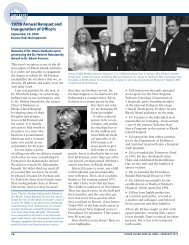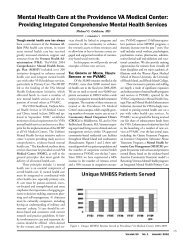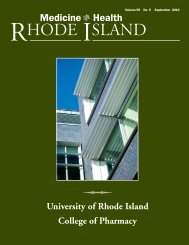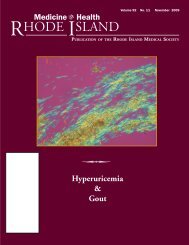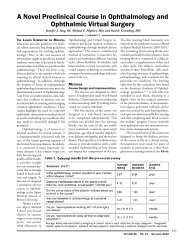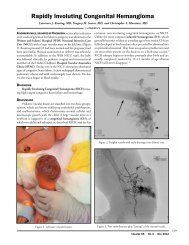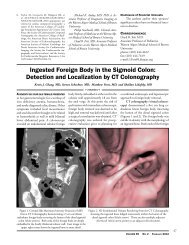The Providence VA Medical Center - Rhode Island Medical Society
The Providence VA Medical Center - Rhode Island Medical Society
The Providence VA Medical Center - Rhode Island Medical Society
- No tags were found...
You also want an ePaper? Increase the reach of your titles
YUMPU automatically turns print PDFs into web optimized ePapers that Google loves.
6Innovative Approaches to Healthcare Delivery at the<strong>Providence</strong> <strong>VA</strong> <strong>Medical</strong> <strong>Center</strong><strong>The</strong> major goal of the <strong>VA</strong> system is costeffective,high quality healthcare. Because<strong>VA</strong> physicians are salaried, there isno entrepreneurial incentive to bill forfee-for-service. Thus, <strong>VA</strong> healthcare providersare more likely to use physicianextenders or other means of expandingoutreach and have therefore developedinnovative methods of delivering care toselected populations of patients. Examplesof innovative modalities of careare described below.MEDICINE & HEALTH/RHODE ISLANDSharon Rounds, MDENHANCING PATIENT ADHERENCETO PRESCRIBED THERAPYObstructive sleep apnea (OSA) isestimated to be present in 9-14% ofmales and 2-7% of females in the US. 1OSA is associated with hypertension,coronary artery disease, and stroke, 2 aswell as motor vehicle accidents resultingfrom excessive daytime somnolence. 3Accumulating evidence indicates thattreatment of OSA with continuous positiveairway pressure (CPAP) decreasesthe prevalence of cardiovascular complications.2 However, although CPAPtherapy is effective in reversing sleep apnea,there is a high rate of non-compliance.An estimated 29-83% of patientswith OSA are non-adherent with CPAPtherapy, defined as use of CPAP at least4 hours per night. 4 Thus, it is importantto develop methods of enhancing compliancewith CPAP treatment for OSA.<strong>The</strong> <strong>VA</strong> provides CPAP therapy forveterans with proven OSA of at leastmoderate severity after evaluation andprescription of CPAP by a pulmonaryphysician. <strong>The</strong> <strong>VA</strong> requires that patientsbe re-evaluated periodically for need forCPAP, in addition to home visits by theCPAP vendor. We developed a novelgroup—CPAP Clinic—managed by apulmonary nurse practitioner and a respiratorytherapist. Veterans for whomCPAP is provided by the <strong>VA</strong> are requiredto attend this clinic every 12-18 months.About 10 patients attend each groupclinic session. <strong>The</strong>ir equipment ischecked for proper function and prescriptionsfor supplies are provided ateach session. Compliance with CPAP isassessed by review of records of machineuse, and patient symptoms and complicationsof CPAP therapy are assessed andtreated. In addition, at each clinic session,a group educational session is held,with nurse practitioner and respiratorytherapist plus compliant patients providingencouragement of CPAP use.In a retrospective review, we assessedcompliance with CPAP therapy betweenpatients who attended CPAP clinic, comparedwith patients who did not attendthe clinic. We found that compliancewith therapy, as defined by 5 hours ofmachine use per night, improved in 29%of patients attending CPAP clinic. 5 <strong>The</strong>success of CPAP clinic is dependent uponuse of physician extenders (nurse practitionerand respiratory therapist) for patientassessment and education and uponthe encouragement provided to noncompliantpatients by compliant patientsalso attending the group clinics.MULTIPLE CARDIO<strong>VA</strong>SCULAR RISKFACTOR INTERVENTIONControl of modifiable cardiac riskfactors for the prevention and treatmentof coronary artery disease (CAD) in patientswith diabetes mellitus decreases therisk of cardiovascular events. However,many patients do not achieve target goalsfor low density lipoprotein (LDL) cholesterol,systolic blood pressure, glycemiccontrol, and tobacco cessation, despiteintensive efforts. Control of multiplerisk factors is expensive, requiring multiplefollow-up physician visits in the traditionalpractice setting.<strong>The</strong> Cardiology Section and thePharmacy Department at the <strong>Providence</strong><strong>VA</strong> <strong>Medical</strong> <strong>Center</strong>, in conjunction withthe School of Pharmacy at the Universityof <strong>Rhode</strong> <strong>Island</strong>, have implemented novelpharmacist-led, multidisciplinary clinics(Cardiovascular Risk Reduction Clinic,CRRC) with interventions to control hyperlipidemia,hypertension, hyperglycemia,and tobacco use. <strong>The</strong> clinics arecoordinated by a clinical pharmacist,working in close collaboration with aphysician cardiologist. Because clinicalpharmacists have prescribing privilegesin the <strong>VA</strong> system within their scope ofpractice, they are able to implementmedication changes, in addition to providingeducation and advice on lifestylemodifications. Furthermore, the <strong>VA</strong>drug formulary is limited and controlled,according to results of clinical studies.Finally, treatment of cardiovascular riskcan be expressed in algorithms that arestrongly supported by clinical trials. Thus,cardiovascular risk reduction is wellsuited for a pharmacist-led clinic.In retrospective reviews, all cardiovascularrisk factors were significantlyimproved after attendance at CRRC programs6 with sustained improvements. 7<strong>The</strong> <strong>VA</strong> is funding a prospective studyto assess the effectiveness of the pharmacist-ledmodel CRRC clinic, underthe leadership of Wen-Chih Wu, MD,<strong>VA</strong> staff cardiologist and Assistant Professorof Medicine at Brown, and TraceyTaveira, PharmD, Associate Professor ofClinical Pharmacy at the University of<strong>Rhode</strong> <strong>Island</strong>.Because of the success of the CRRC,pharmacist-led clinics in conjunctionwith cardiology have also been establishedat the <strong>Providence</strong> <strong>VA</strong>MC for congestiveheart failure, another conditionfor which strong evidence from clinicaltrials supports algorithms for clinicalmanagement.TELEDERMATOLOGYWorkforce surveys have documenteda national shortage of dermatologists. 8 Thisproblem is exacerbated in rural areas withlong travel distances to dermatology providers.<strong>The</strong> practice of medical dermatologyis well suited for telemedicine, sinceskin lesions are easily documented andtransmitted. <strong>The</strong> availability of an electronicmedical record with robust securityfor personal health information, suchas the VistA system used by the <strong>VA</strong>, is criticalfor successful teledermatology.




